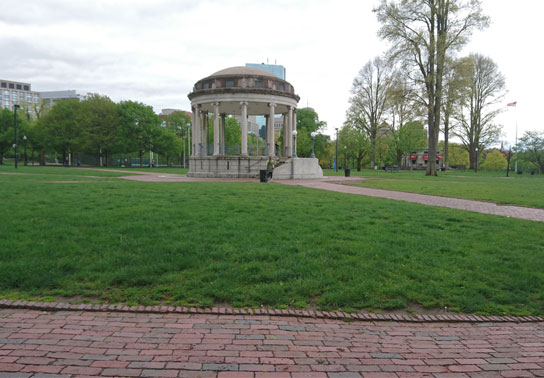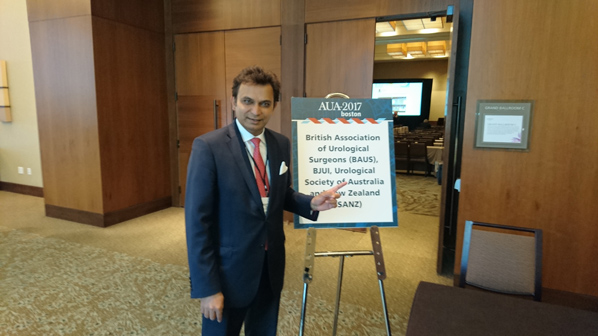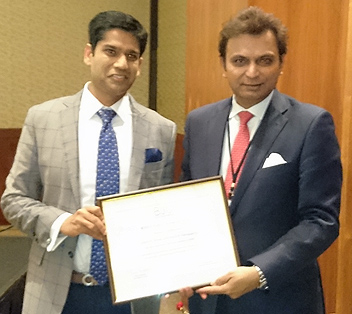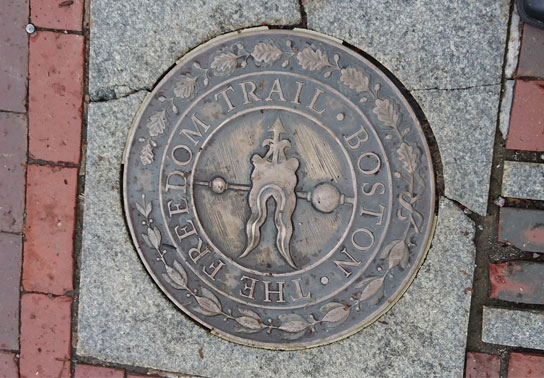#AUA17: Highlights from Boston part 2
The #AUA17 meeting was starting to hot up with the anticipation of the crossfire sessions controversy in urology, second opinion cases and surgical technique plenary session. The early crossfire session was looking at adult onset hypogonadism. The debaters gave convincing arguments on both sides of the discussion but we were left in no doubt that adult-onset hypogonadism is a true medical condition and urologists need to recognise the symptoms and treat when appropriate.
Adult onset hypogonadism IS a true medical condition. Urologists should champion appropriate #testosterone use. #AUA17 #lowT #MensHealth pic.twitter.com/DvEZWqBWO6
— Ashley Winter MD || Urologist (@AshleyGWinter) May 14, 2017
There was a lively crossfire debate on the use off transperineal biopsy vs TRUS biopsy for the detection of prostate cancer. There we some moral arguments in favour of transperineal biopsy stated. Laurence Klotz presented the AUA MRI targeted biopsy consensus statement.
#AUA17 Plenary Crossfire TP v TRUS biopsies – @daviesbj argues persuasively against TP pic.twitter.com/amrnIerTXu
— 𝚁𝚞𝚜𝚝𝚘𝚖 𝙼𝚊𝚗𝚎𝚌𝚔𝚜𝚑𝚊 (@Dr_RPM) May 14, 2017
In an era of antibiotic resistance, should we move the prostate biopsy needle from trans rectal to trans perineal? #AUA17 @AmerUrological pic.twitter.com/U7Mq7GH0Mw
— Madhur Nayan (@DrMadhurNayan) May 14, 2017
Comparing hospitalization rates at #AUA17 Crossfire debate @daviesbj pic.twitter.com/dX8ZDBtPkt
— Amer. Urol. Assn. (@AmerUrological) May 14, 2017
.@KlotzLaurence presenting @JUrology highlights in #prostatecancer
MRI targeted biopsy consensus statement is a must read. #aua17 #pcsm pic.twitter.com/LzcyX7ztku
— Angie Smith (@angiesmith_uro) May 13, 2017
The results of the 24 months follow-up of the aquablation study was presented. The mean operative time was 45 mins with a aquablation time of 5 mins! There was a 34% prostate volume reduction. There were no cases of urinary innocence , ejection or erectile dysfunction. The WATER study was presented comparing aquablation vs TURP. The study found aqua ablation superior to TURP in terms of safety, Q max and IPSS reduction. We look forward to long term data but the initial results presented look promising
Promising results of Aquablation at 2yr! 45' operative time-34% prostate volume reduction
Excited to see WATER study results tomorrow #AUA17 pic.twitter.com/bbiTsqRXg5— Benjamin Pradere (@BenjaminPradere) May 13, 2017
Amazing how many ways we continue to try and attack the prostate for BPH. #AUA17 pic.twitter.com/6U9ZPe13vz
— Matthew Bultitude (@MattBultitude) May 16, 2017
#bph WATER STUDY Aquablation > TURP especially for 50-80cc. OR time size independent. @VMisrai @BenjaminPradere #Aua17 @Aquablation pic.twitter.com/CLp1DHkALa
— Dr_KevinZorn (@Dr_KevinZorn) May 14, 2017
In a packed breakfast session we were given an excellent overview of the role of Immune checkpoint inhibitors in bladder cancer. The audience was treated to a state-of-the-art update on the newer drugs on the horizon, their indications, side effects and early clinical trial data. Watch his space for the new check point inhibitors for treatment of metastatic bladder cancer.
Immune Checkpoint Inhibitors in #BladderCancer – Urologist’s Perspective #AUA17 @OncoBellmunt @bsauser https://t.co/kJTu2q64nP
— Ashish M. Kamat, MD, MBBS (@UroDocAsh) April 28, 2017
Burnout was a main theme across many of the sessions at the AUA. The poster by Nash et al. looked at results from the AUA census. They found that 41% of urologist surveyed between the ages of 29-65 experienced burnout. Other risk factors included working in a multi speciality practise. Paediatric urologists and urologist older than 65 were least likely to suffer from burnout. Very important issues have been highlighted at this meeting and gives food for thought for us all.
.@anorth21 presents interesting research about #BurnOut in #Urology from 2016 AUA Census: 41% 29-65yo urologists experience burnout. #AUA17 pic.twitter.com/ChfwuIBuya
— Amanda Chung (@AmandaSJChung) May 15, 2017
Come listen to the burnout data from the 2016 AUA Census. Room 156 right now!!! #aua17 pic.twitter.com/MiIQg3SPtr
— Amanda North (@anorth21) May 15, 2017
#AUA17 recognising burnout amongst physicians, causes multifactorial, increasing workload/pressures,exercise good,recognise early @nshrotri pic.twitter.com/LBa2bjyhfW
— ben eddy (@DrBenEddy) May 13, 2017
Dr. Pruthi leading international panel discussion on topic of burnout in urology in #AUA17 plenary pic.twitter.com/JqPCbeYq7o
— Urology@UNC (@UNCurology) May 13, 2017
Dr. Pruthi discussing #burnout in urology at Society for Academic Urology #AUA17 pic.twitter.com/6g5Wx6wldu
— Urology@UNC (@UNCurology) May 11, 2017
The eagerly awaited results of the randomised open verses robotic cystectomy (RAZOR) trial was announced at the AUA. the findings of the study showed that robotic cystectomy is not inferior to open cystectomy with respect to 2 year progression free and overall survival. As expected blood loss, length to stay favoured the robotic cystectomy group but complication rates, overall surgical margins and lymph node yield were similar.
#AUA17 RAZOR trial RARC vs ORC @dipenjparekh–
1. Similar 2year survival
2. RARC <blood loss+LOS
3. ORC <time
4. RARC >soft tissue marginpic.twitter.com/A9l9kJl6RL
— Prokar Dasgupta (@prokarurol) May 15, 2017
Bladder cancer diagnosis cost effectiveness was highlighted in a plenary session. Cost-effectiveness of ultrasound vs CT with cystoscopy was presented. The study found that the use of CT rather than ultrasound increased costs by $65 million / 1 cancer detected. This study highlights the need to risk stratify the use of CT in investigation of patients with non visible heamaturia.
US/ cysto most cost effective for micro haematuria. Costs $65 million !!! to use CT to find one cancer. Hence need to risk stratify #AUA17 pic.twitter.com/K95ByLiLi8
— Matthew Bultitude (@MattBultitude) May 16, 2017
One of the major announcements was the much anticipated phase 3 trial results looking at immediate post-TURBT instillation of gemcitabine vs saline in patients with newly diagnosed or occasionally recurring low grade non-muscle invasive bladder cancer, SWOG S0337. The study shows reduced recurrence by 34% with little toxicity. There was a lot of excitement regarding gemcitabine as it 5-10 times cheaper than the widely used mytomycin C.
Much anticipated P3 trial results post-TURBT gemcitabine @SWOG S0337 – reduces recurrence by 34% + little toxicity #AUA17 pic.twitter.com/sgTff4j0LT
— Peter Black (@pcvblack) May 15, 2017
IPOP gemcitabine. Good news for NMIBC @LarreStephane @MRoupret #AUA17 pic.twitter.com/lXYlpH3YPZ
— Catalin Ciuta (@cataciuta) May 15, 2017
@uretericbud Anyone know the cost of gemcitabine vs mitomycinC for intravesical administration ? They look about as effective.. #AUA17
— Tim O'Brien (@tsoburol) May 15, 2017
Well at least there's good news in NMIBC! #gemcitabine #AUA17
Practice changing SWOG trial. pic.twitter.com/a5Tgnqpaz0— Matt Cooperberg (@dr_coops) May 15, 2017
The BAUS-BJUI-USANZ joint session was a fantastic overview from some of the top UK, US and Australian urologists. The highlights of the session included the talks on personalised medicine. The president of the British Association of Urological Surgeons Mr Kieran O’Flynn gave an insightful talk on training and inspiring the next generation of urologists. This was followed up by the Australian perceptive on urological training for the future. Khurshid Guru, Director of Robotic Surgery at Roswell Park Cancer Institute, gave an overview of cognitive training in surger . Finally the Coffey-Krane Award – the BJUI Journal prize for trainees based in The Americas – was awarded to Drs. Ranjith Ramasamy and Jason Kovac on their paper titled ‘Hypogonadal symptoms in young men are associated with a serum total testosterone threshold of 400 ng/dL’.
Dr Ramasamy receives the 2017 Coffey-Krane prize from Prof Dasgupta
The Christchurch Medal was awarded to Dr. Catherine deVries for her work on developing urological training programs in Asia, Africa, and Latin America. Congratulations to all the award winners and the BJUI team on an exceptional programme.
.@prokarurol ready for the BAUS-BJUI-USANZ session, Westin Ballroom CDE #AUA17 pic.twitter.com/9rK28b7W3u
— BJU International (@BJUIjournal) May 14, 2017
#AUA17 We can train surgeons in less time if we are smarter @BAUSurology @EardleyIan pic.twitter.com/LYePRmHkAQ
— Prokar Dasgupta (@prokarurol) May 15, 2017
The BAUS-BJUI-USANZ joint session recommences with the President of @USANZUrology introducing the President of @BAUSurology #AUA17 pic.twitter.com/qwP4NYtHXl
— BJU International (@BJUIjournal) May 14, 2017
In a busy trauma symposium the management of grade 4 renal injuries was presented. A multi centre study looking at safety in early mobilisation after renal trauma examined the benefits. The study concluded that the advantages for early mobilisation included increase in return of bowel function, reduced length of hospital stay, but acknowledged the increased risk of early mobilisation in higher grade traumas. One study looking specifically at outcomes in grade 4 renal injuries found 14% of the patients were unstable on presentation, 52% required a blood transfusion with 24 hours and 74% of those with grade 4 renal injury had associated injuries.
another TRAUMAFUF study presented by @BPeyronnet early mobilization is safe after renal trauma!#AUA17 pic.twitter.com/nhmpIi07Mf
— AFUF (@afufuro) May 16, 2017
Frank Burks is presenting AAST data on renal trauma at plenary #AUA17 pic.twitter.com/bOOfSsUSjE
— Dmitriy Nikolavsky (@UroRecon) May 15, 2017
Great points for pro conservative management in AAST Grade IV renal trauma! Can't wait for con! @richsantucc @SocietyGURS #AUA17 pic.twitter.com/GkeIk5qjIV
— David Z Qi (@UroNerdist) May 15, 2017
Trauma Guidelines highlighted in complex case discussion #AUA17 @AmerUrological @JSimhan @sbran78789 @SocietyGURS @endourologyccf pic.twitter.com/4zT0ZGwCiE
— Alex Small (@alexcsmall) May 16, 2017
The medical expulsive therapy (MET) debate rumbled on in 2017 at the AUA. Results of the late breaking abstract the Study of Tamsuolsin for Urolithiasis in the Emergency department (STONE) was presented. The end point was stone passage at 28 days, with CT used to confirm stone passage. The study found no difference for stone passage rates for stones less than 9 mm compared to placebo.
Medical expulsive therapy: Turns out the drugs still don't work in another large RCT – NO benefit to MET. The debate is over! #AUA17 pic.twitter.com/9c58x1N0NF
— Matthew Bultitude (@MattBultitude) May 14, 2017
Alpha blockers are dead. Nih STONE study confirms suspend trial. Late breaking now #aua17. Plenary pic.twitter.com/eJVdErPxBH
— Manoj monga (@endourologyucsd) May 14, 2017
At the ROCK session UK urologist Matthew Bultitude (@MattBultitude) gave an excellent case against MET has he debated with John Hollingsworth. It is safe to say now ‘MET IS DEAD’
Afraid #Hollingsworth was gladiat-ed #aua17 and that too I love MET
@ROCKUrology @MattBultitude pic.twitter.com/ZfA26R5KPl
— Khurshid Ghani
(@peepeeDoctor) May 15, 2017
Don't throw baby out with bath water. MET has a place for large distal ureteral stones @MattBultitude#MET #AUA17@BJUIjournal@ROCKUrology pic.twitter.com/rY6OYVgv8O
— kevin don (@TangKun_Urology) May 16, 2017
The NBA playoff final were on the Monday evening with the Boston Celtics beating the Washington Wizards 115-105 in Game 7 of the Eastern Conference semi-finals. Many of the conference attendee took time out to watch the game live and support their adopted team the Boston Celtics.
After a good #AUA17 now in the TD Garden for the 7th game of the NBA playoffs. Let's go Celtics! Urology&Basketball pic.twitter.com/qL4XxGNWkr
— Daniel Pérez Fentes (@dperfen) May 16, 2017
After a good #AUA17 now in the TD Garden for the 7th game of the NBA playoffs. Let's go Celtics! Urology&Basketball pic.twitter.com/qL4XxGNWkr
— Daniel Pérez Fentes (@dperfen) May 16, 2017
Groene @urologen @BKUroloog @Dokter_Flow bij @celtics #aua17 pic.twitter.com/7gWvXLv8hD
— Carl Wijburg (@roboturoloog) May 16, 2017
@DocJMB again! After 15 years! #aua17 @celtics #NBA pic.twitter.com/HjtYlvynZM
— Carl Wijburg (@roboturoloog) May 15, 2017
It has been another excellent AUA in Boston. It was good to catch up with old friends and urologists from across the globe to debate and update on the latest management in urology. It was another record breaking year for the #AUA17 on twitter. It surpassed the stats for #AUA16 with over 52 million impressions, 20,530 tweets 3,591 participants. See you all in San Fransisco for AUA 2018.
Thanks to everyone who tweeted during #AUA17 to help achieve another record-breaking year! pic.twitter.com/uz6D7eSkpv
— Amer. Urol. Assn. (@AmerUrological) May 17, 2017
Farewell Boston! Thank you for another wonderful AUA #AUA17 pic.twitter.com/EMKbf6LqYF
— John Michael DiBianco (@DrJohnMDiBi) May 15, 2017
By Jonathan Makanjuola (@jonmakurology) and Nicholas Raison (@NicholasRaison)






